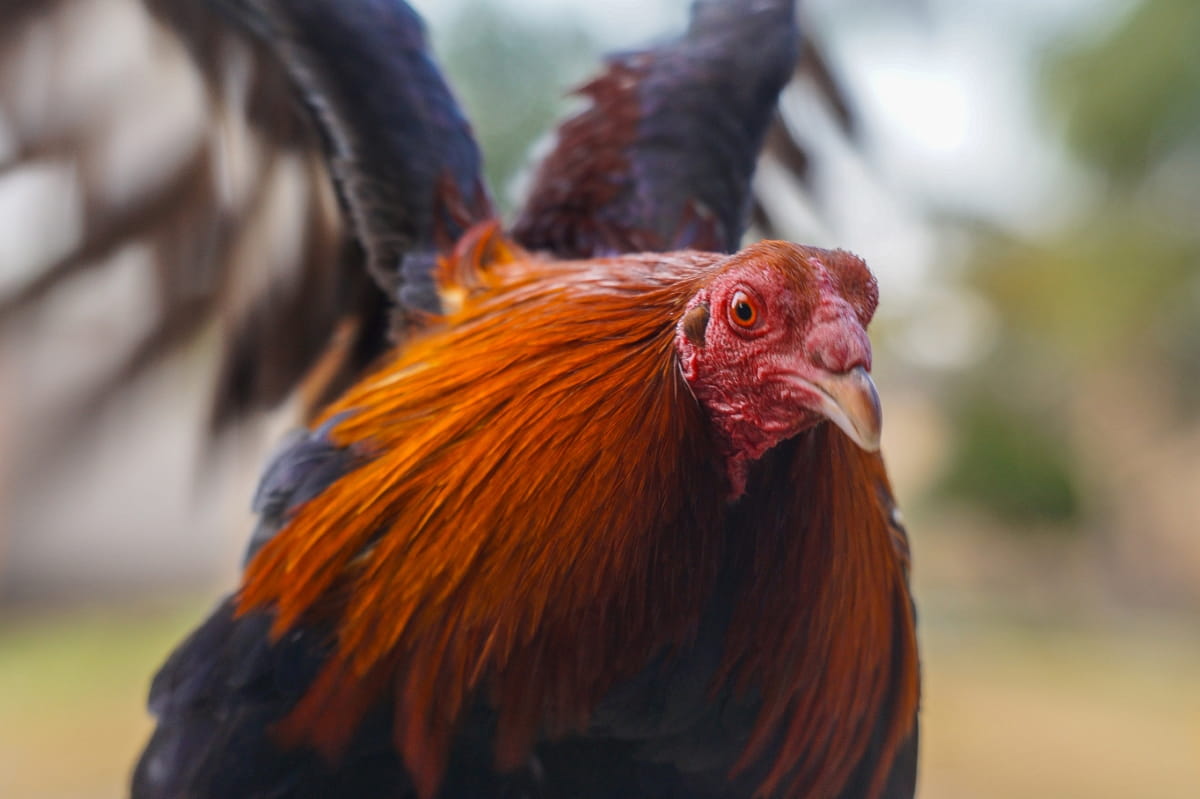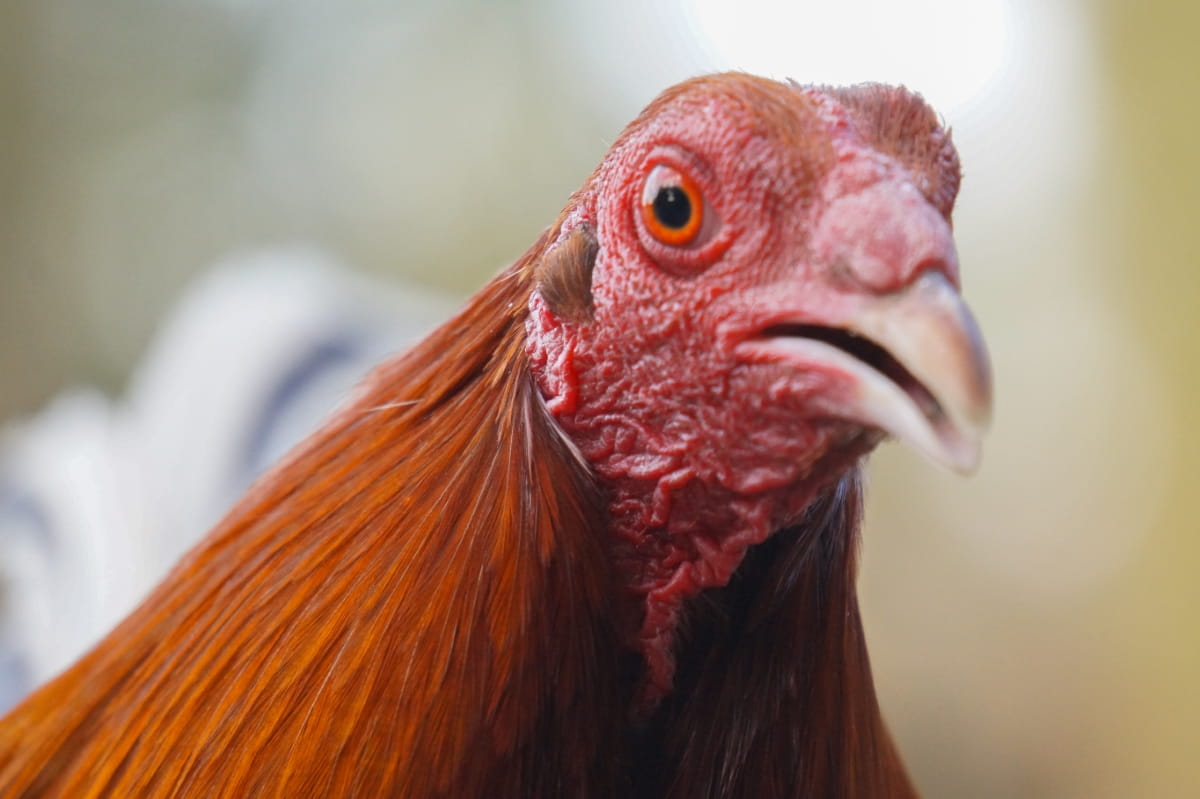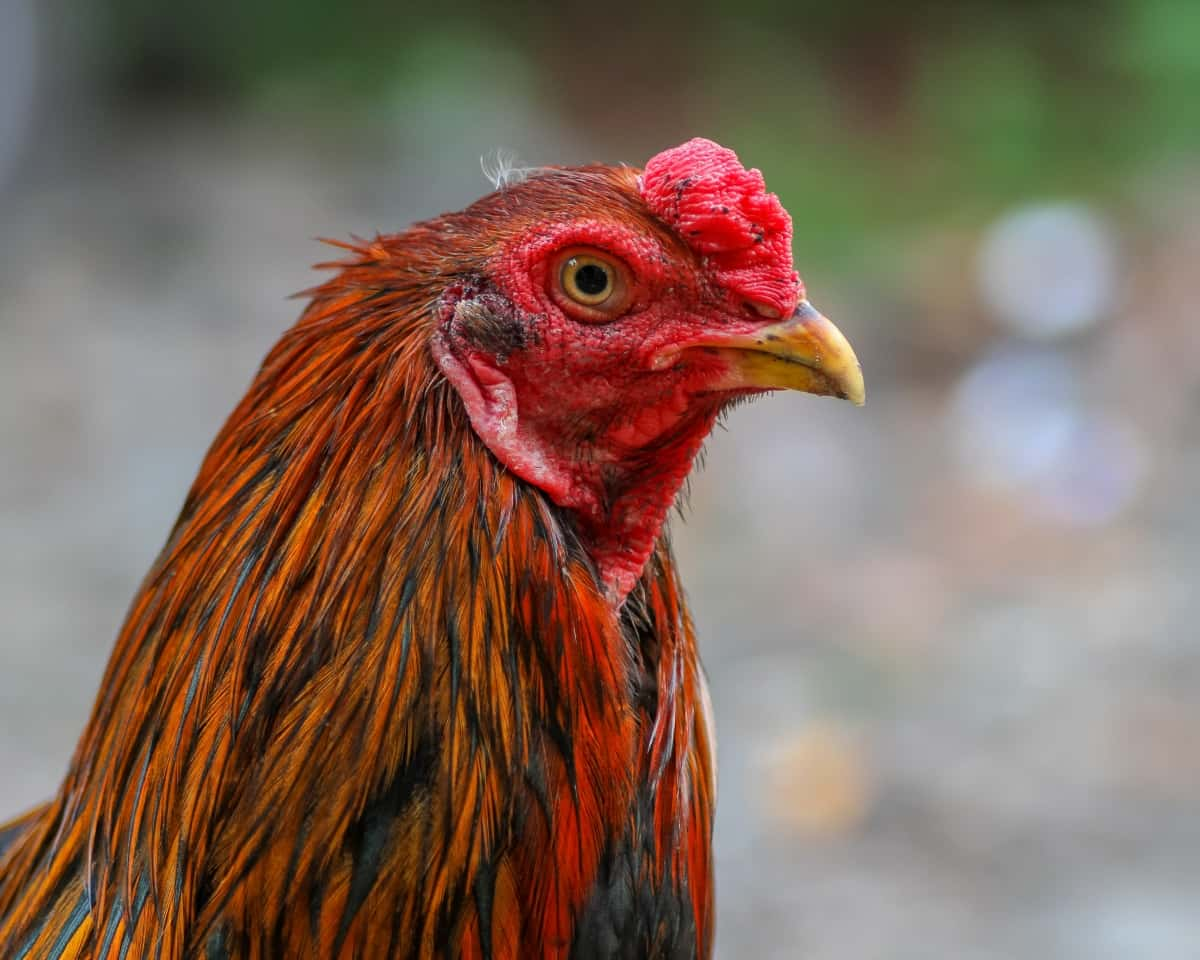Red Quill Gamefowl history traces its lineage to the 1800s when Irish immigrants brought their prized gamefowl to America. The breed’s foundation is rooted in the Irish Game, Claret, and Old English Game bloodlines. Known for their fighting prowess and distinct appearance, the Red Quill fighting style quickly gained popularity in cockfighting circles across the United States. The Red Quill gamefowl are medium to high weight with an average weight of 2 to 2.4 kgs.
Physical Characteristics
Red Quill chickens exhibit a striking appearance with their vibrant red plumage, accented by black tail feathers and hackles. They boast a compact, muscular build, with powerful legs ideal for combat. Their distinctive yellow legs and bright red eyes add to their formidable presence in the ring.
Temperament and Behavior
Renowned for their bold and courageous nature, Red Quills possess an inherent fighting spirit. Despite their aggressive tendencies in the ring, they often display docile and friendly behavior towards humans when properly socialized. With care and training, they can also adapt well to a domestic setting, exhibiting loyalty and affection to their owners.

Breeding Red Quill Gamefowl
Selecting Breeding Stock
When choosing breeding Red Quill gamefowl stock, prioritize birds with desirable traits such as strong confirmation, vibrant plumage, and a history of successful fighting or performance. Look for individuals with good health, vigor, and temperament to pass on these qualities to future generations.
Breeding Strategies
As Gamefowl breeding techniques, implement a careful line-breeding program to consolidate desirable traits while minimizing genetic weaknesses. Rotate breeding pairs to avoid inbreeding depression and maintain genetic diversity. Keep detailed records to track lineage and performance, allowing for informed breeding decisions.
Common Breeding Challenges
Common challenges in breeding Red Quill Gamefowl include maintaining genetic diversity, avoiding inbreeding, and addressing health issues such as respiratory infections or parasites. Additionally, managing aggression among breeding pairs and ensuring proper nutrition and care for both parents and chicks are essential for successful breeding outcomes. Regular monitoring and proactive veterinary care can help mitigate these challenges.
Raising Red Quill Baby Chickens
Incubation and Hatching
Incubate Red Quill eggs at a consistent temperature of around 37.5°C with a relative humidity of 50-60% for 21 days. Turn the eggs several times a day until three days before hatching, then cease turning. Ensure proper ventilation and sanitation within the incubator to prevent bacterial growth and ensure successful hatching.
Brooding and Early Care
After hatching, transfer baby chickens to a clean, warm brooder with a temperature of around 35°C initially, gradually decreasing by 2.5°C per week. Provide a balanced chick starter feed and fresh water, along with a safe and comfortable environment free from drafts and predators.
Health Monitoring and Vaccination
Regularly monitor chick health, checking for signs of illness or distress such as lethargy, abnormal feces, or respiratory issues. Consult a veterinarian for appropriate vaccinations against common poultry diseases like Marek’s disease and Newcastle disease to bolster their immunity and prevent outbreaks. Implement strict biosecurity measures to reduce the risk of disease transmission.
In case you missed it: How to Avoid Calcium Deficiency in Chickens

Feeding and Nutrition
Nutritional Requirements
Red Quill Gamefowl nutrition and diet involve a balanced diet to support their growth, performance, and overall health. Their diet should consist of high-quality poultry feed containing nutrients like protein, vitamins, minerals, and carbohydrates. Provide access to clean and fresh water at all times to avoid dehydration and aid digestion.
Feed Types and Schedules
As best feeds for Red Quill gamefowl, Offer a combination of formulated pellets or crumbles and whole grains such as corn and wheat. Feed chicks starter feed for the first 6-8 weeks, then transition to grower feed until maturity. Provide fresh feed and clean water daily, adjusting quantities based on age, activity level, and environmental conditions.
Supplements and Health Boosters
Consider supplementing their diet with probiotics to promote gut health and improve nutrient absorption. Additionally, offers calcium supplements like crushed oyster shells to support bone strength and eggshell formation in laying hens. Ensure access to grit for proper digestion, and periodically incorporate treats like fruits, vegetables, or mealworms for enrichment and added nutrition.
Housing and Environment
Gamefowl Coop Design and Setup
Construct a sturdy coop with ample ventilation, natural light, and insulation to provide a comfortable environment for Red Quill Gamefowl. Include roosting bars, nesting boxes, and easy-to-clean flooring such as wood shavings or straw. Ensure proper drainage to prevent moisture buildup and minimize disease risks. Install predator-proof locks on doors and windows to secure the coop at night.
Space Requirements
Provide at least 4 square feet of indoor space per bird, with additional outdoor space for ranging and foraging. Allow for sufficient room for social interaction and exercise, especially during inclement weather when outdoor access may be limited.
Protection from Predators
Secure the coop with sturdy fencing buried at least a foot underground to deter digging predators like foxes and raccoons. Install hardware cloth over windows and vents to prevent entry by small predators such as rodents and snakes. Consider using motion-activated lights or alarms to deter nocturnal predators.
Health and Wellness
Common Health Issues
Red Quill Gamefowl, like all poultry, are susceptible to various health issues. Common concerns include respiratory infections, parasites (such as mites and worms), injuries from fights or rough housing, and nutritional deficiencies. Watch for signs of illness like lethargy, decreased appetite, abnormal feces, or respiratory distress, and address any concerns promptly.
Red Quill Gamefowl Care
Always maintain a clean and dry environment to prevent the buildup of pathogens and parasites. Provide a balanced diet, fresh water, and access to grit for proper digestion. Implement a vaccination program against common poultry diseases and practice strict biosecurity measures to minimize the risk of disease transmission.
Treatment and Medication
Consult with a veterinary doctor for diagnosis and treatment of specific ailments. Treatments may include antibiotics for bacterial infections, dewormers for parasitic infestations, and supportive care such as wound cleaning and bandaging for injuries. Follow medication dosages and withdrawal periods carefully to avoid antibiotic resistance and Gamefowl health and wellness.
Training and Conditioning
Training Basics for Gamefowl
Training Red Quill Gamefowl begins with early socialization to familiarize them with human interaction and handling. Gradually introduce basic commands such as recall and perch training using positive reinforcement techniques like treats and praise. Encourage natural behaviors like foraging and scratching to maintain their instinctual skills.
Conditioning Techniques
Red Quill Gamefowl conditioning involves physical fitness, mental sharpness, and honing fighting instincts. Implement a structured exercise regimen that includes regular free-ranging, flying, and wing-flapping exercises to build strength and endurance. Additionally, utilize sparring sessions with other birds or a dummy to sharpen fighting skills and improve agility.
Preparing for Competitions
Prior to competitions, focus on fine-tuning conditioning and fighting techniques. Increase the intensity as well as duration of training sessions to peak performance levels. Adjust diet to optimize energy levels and muscle development. Familiarize birds with the competitive environment to reduce stress and anxiety. Ensure birds are in optimal health by conducting pre-competition health checks.
In case you missed it: Lavender Orpington Chickens: All You Need to Know

Ethics and Legal Considerations
Understanding Gamefowl Legislation
Familiarize with the laws and regulations governing gamefowl in your region. These laws can vary widely, covering aspects such as ownership, breeding, fighting, transportation, and sale of gamefowl. Adherence to these laws is crucial to avoid legal repercussions and ensure the welfare of the birds.
Ethical Breeding and Raising Practices
Practice ethical breeding by prioritizing the health, well-being, and welfare of the birds above all else. Avoid engaging in activities that promote or condone cruelty, such as illegal cockfighting. Provide appropriate housing, nutrition, veterinary care, and socialization for your birds. Maintain standards of hygiene and cleanliness to prevent disease and promote overall health.
Participating in Legal Competitions
If you choose to participate in legal competitions such as poultry shows or exhibitions, ensure compliance with all applicable laws and regulations. Seek out reputable organizations and events that prioritize the welfare of the birds and promote responsible ownership and breeding practices. Participate in competitions that celebrate the beauty, diversity, and heritage of gamefowl breeds without promoting or condoning illegal activities such as cockfighting.
Conclusion
Raising and caring for Red Quill Gamefowl requires dedication, knowledge, and ethical consideration. By adhering to legal aspects of gamefowl breeding, promoting ethical practices, and participating in legitimate competitions, enthusiasts can appreciate and preserve the legacy of the Red Quill Gamefowl breed for generations to come.
Note: The images presented in this post are intended solely for representation purposes. The images are meant to serve as visual aids and should not be relied upon as accurate representations of their real-life counterparts.
- Feed Your Flock for Less: Top 10 Tips to Save on Chicken Feed
- Ultimate Guide to Ossabaw Island Hog: Breeding, Raising, Diet, and Care
- Hatching Answers: The Top 10 Reasons Your Chickens Aren’t Laying Eggs
- Eggs and Economics: Breaking Down the Cost of Raising Backyard Chickens
- Defend Your Greens: Proven Methods to Keep Iguanas Out of Your Garden
- Ultimate Guide to Cinnamon Queen Chicken: A Comprehensive Guide for Beginners
- Ultimate Guide to California Tan Chicken: Breeding, Raising, Diet, Egg-Production and Care
- Ultimate Guide to Marsh Daisy Chicken: Breeding, Raising, Diet, and Care
- 10 Types of Chicken Farming Businesses You Can Start for Profits